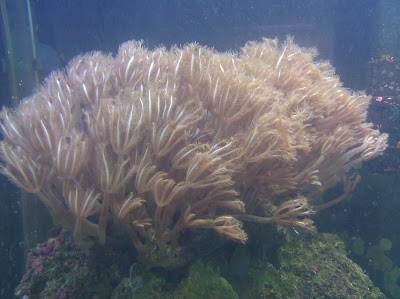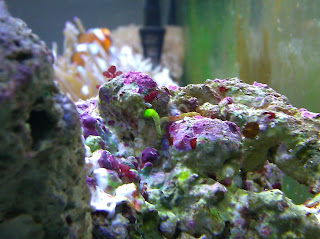Been a while since my last post. I've mostly been hanging out at the
Reef Tank forums... learning. So I suppose a few updates are in order:
My single Stomatella now has company. I've noticed at least three others.
Since turning my power filter into a chaeto house, water quality seems more stable. Sure, there are nitrates, but they aren't increasing on a daily basis. And it's been just over a week since the last water change. I'm not stretching it to see how far I can go, but I'd also like to not have to blow through 50 pounds of salt in 6 weeks, either.
The last time I removed the power filter I noticed a single Neomeris annulata. Then when incorporating the power filter once again, the annulata seemed to bleach and nearly go away. This time I have a small mat of them. I'll get pictures up sometime soon.
Within the past couple of days I've had another algae bloom. Mostly cyanobacteria. So any pictures before the next water change will reflect such.
I'm down to feeding the anemone once a week. I generally give it three or four freeze-dried krill. I'm basing this on the amount of krill I found during it's last waste expulsion. It could probably eat every 5 days, but that's not the easiest thing to keep track of, so once a week it is.
I'm also noticing the beginning of purple and green coraline algae spots on the back glass. I tend to neglect the back glass hoping that a coral will attach and use it as a growing surface. Some corals seem like they only grow on the purple coraline, and others... well, I can't really see their perch like I can with star polyps so I can't really tell.
Lost another Dwarf Hermit Crab three days ago. Not sure why. Perhaps a lack of food? I doubt it, but I don't know for sure. The others (down to 6 from 10) seem to all be doing fine. I don't know if I blogged about it, but a couple weeks ago I went and got 6 new larger shells for them. At least three have changed shells. I know for sure two of the larger ones have the new shells, and the smallest has move into one of the discarded shells.
I'm still working on charting water quality time frames comparing a power filter tank with a non-power filter tank. It's a work in progress and will be published when results have sufficient data.
Running without the power filter (and a sump) definitely has it's drawbacks, but I'm learning to live with some particulates in the water. They do eventually settle (over a few days vs a few hours), but are still in the tank waiting to be stirred up again. I think that's why I'm letting the cyano and other algaes get more of a foothold than normal. I'm hoping the algae, when removed, will take some of the settled particulates with them.
Other than the process of planning a benthic sump (which will obviously be documented), nothing much else going on except tank watching and forum reading. I'll see what I can do to get pictures up soon.





















































